
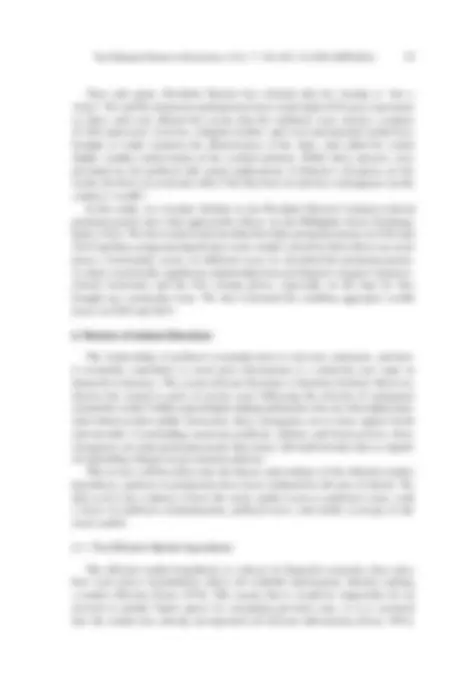
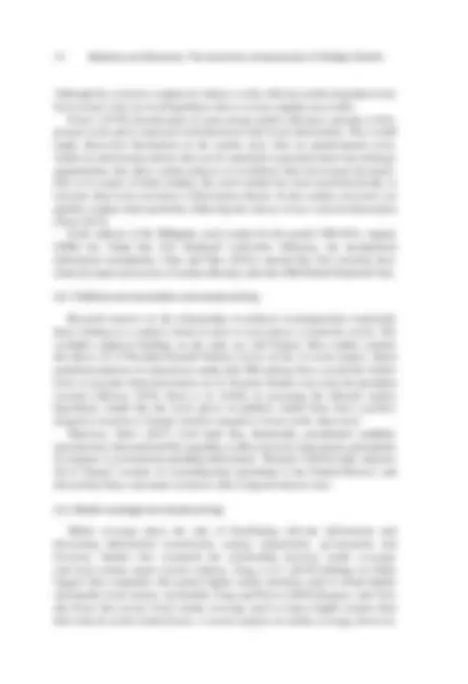
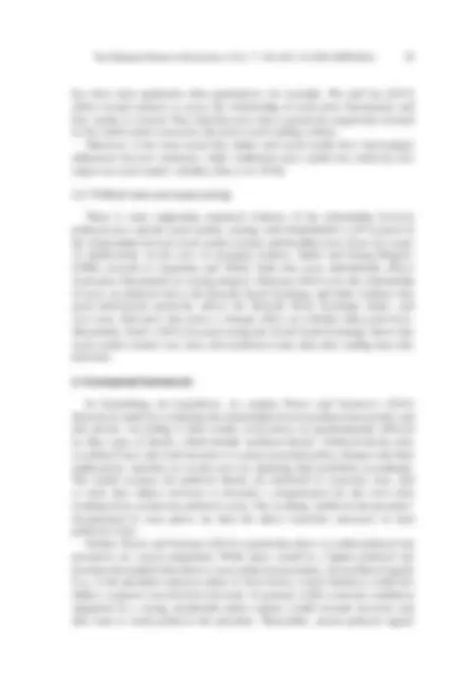
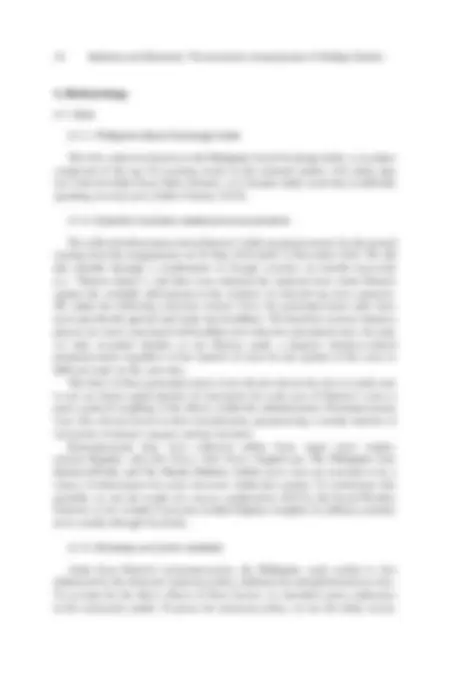
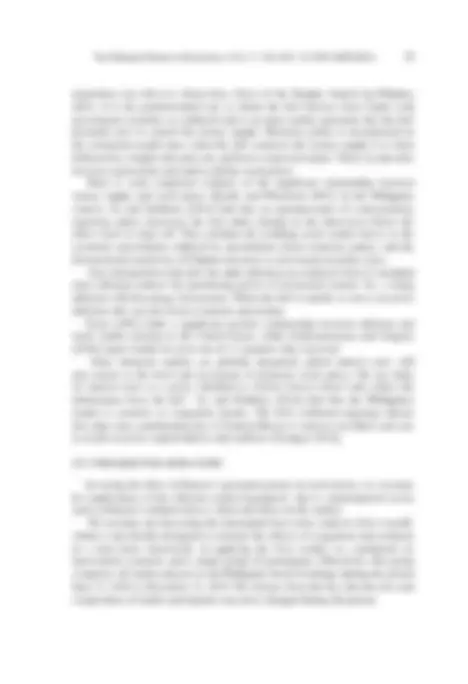
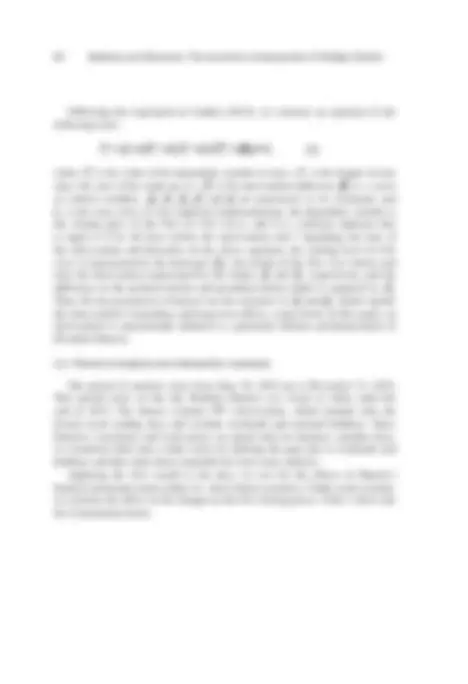
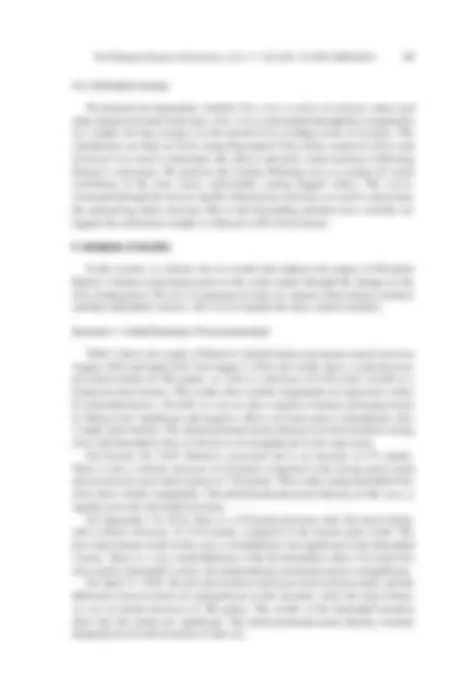
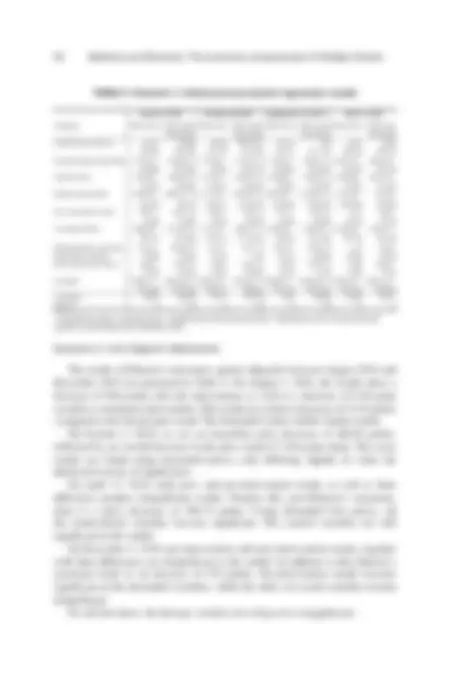
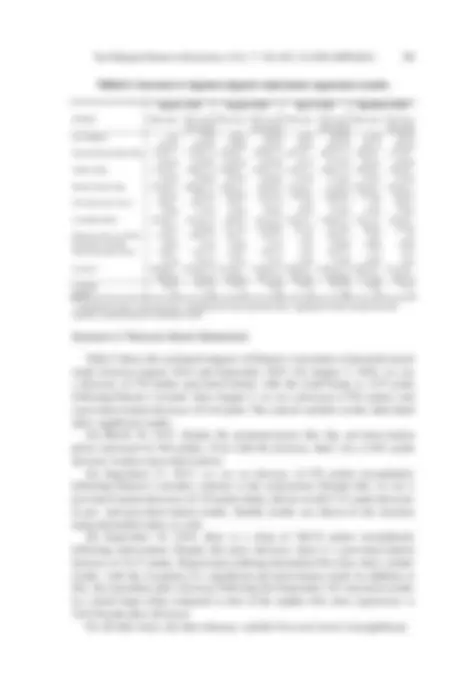
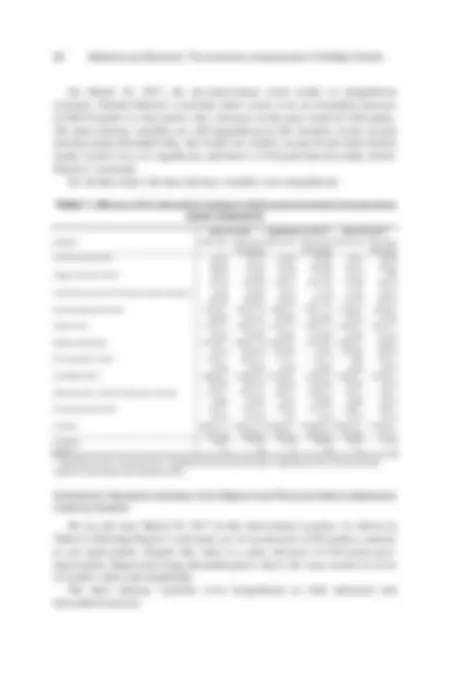
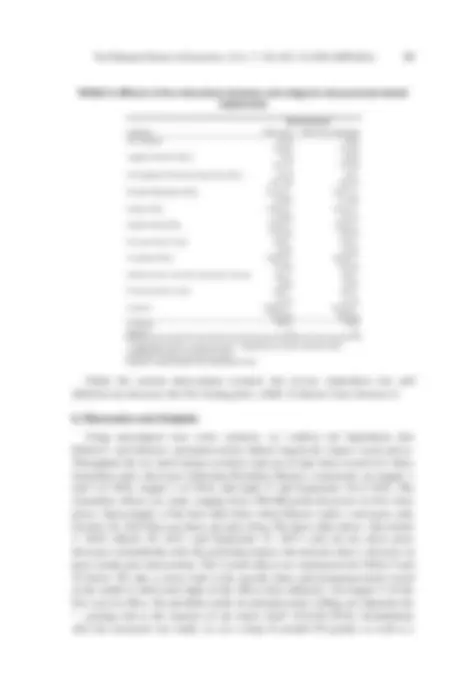
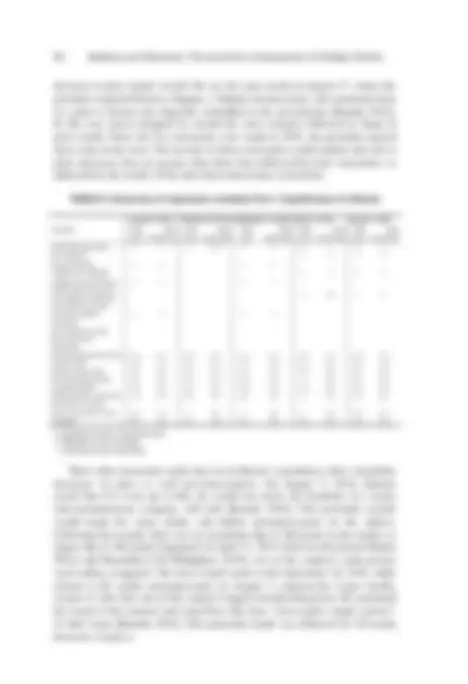
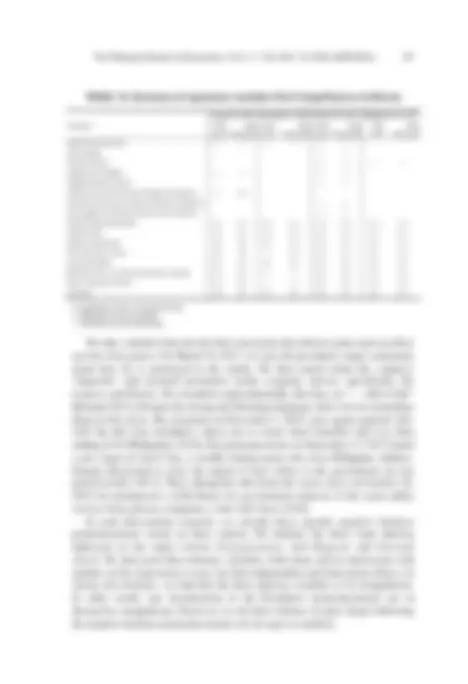
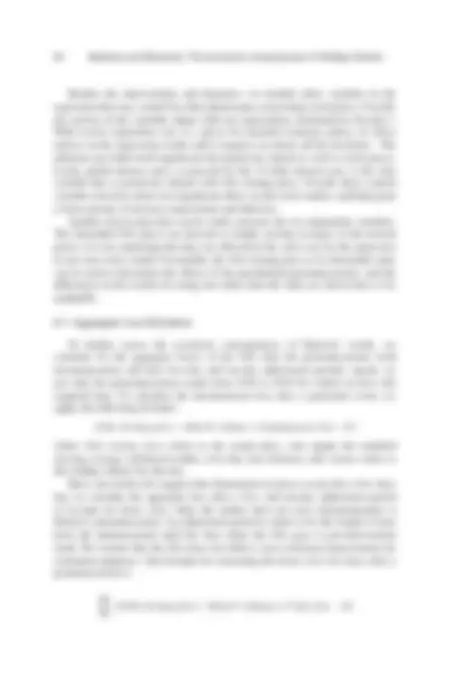
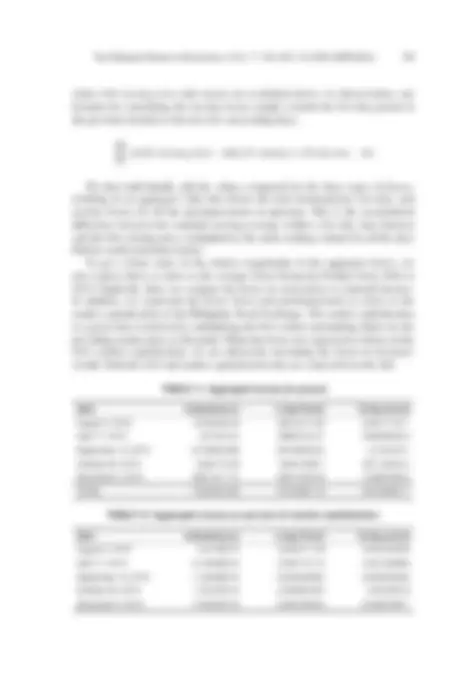
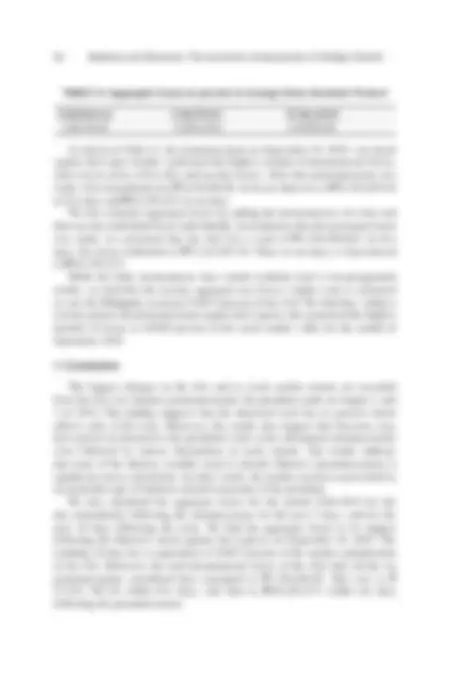
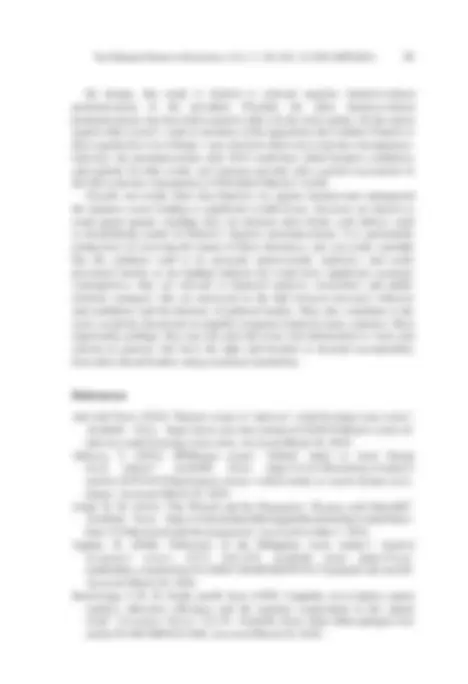
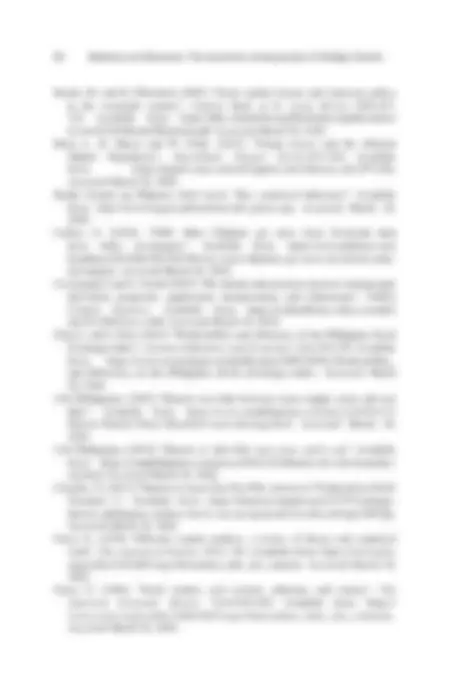
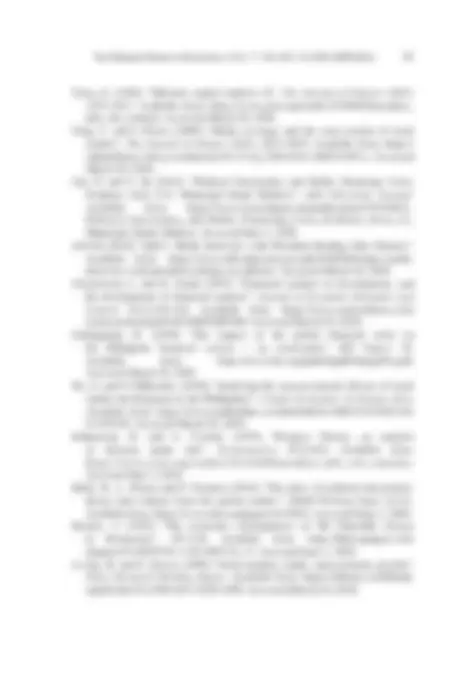
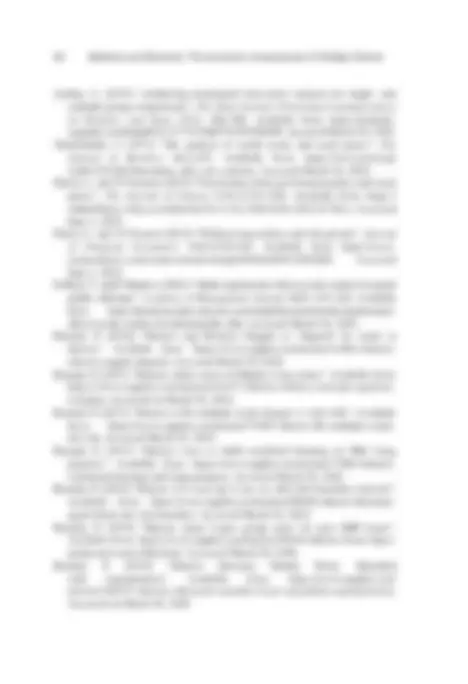
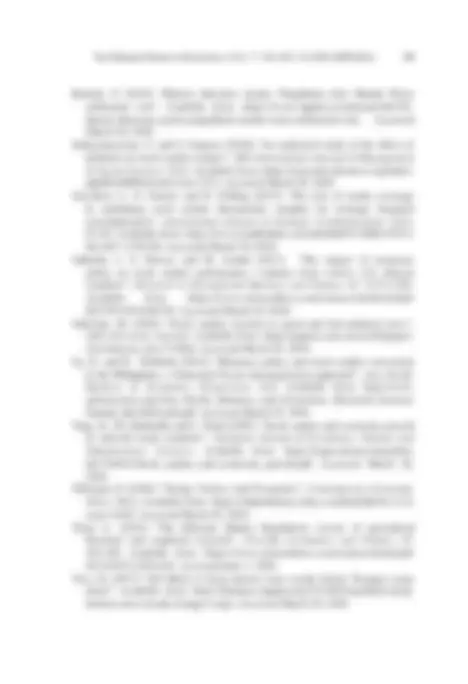
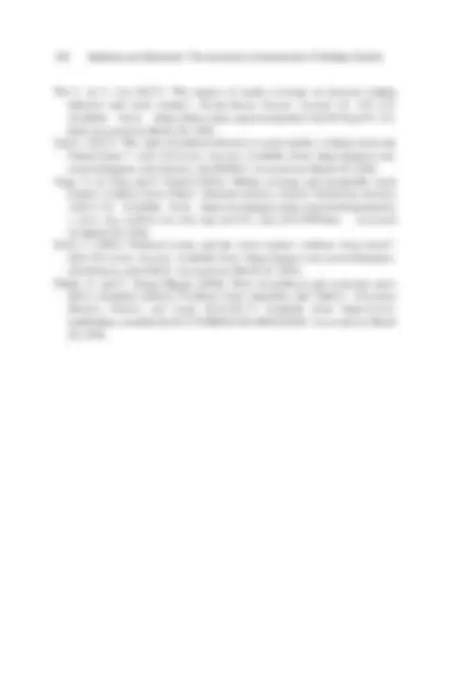


Study with the several resources on Docsity

Earn points by helping other students or get them with a premium plan


Prepare for your exams
Study with the several resources on Docsity

Earn points to download
Earn points by helping other students or get them with a premium plan
Community
Ask the community for help and clear up your study doubts
Discover the best universities in your country according to Docsity users
Free resources
Download our free guides on studying techniques, anxiety management strategies, and thesis advice from Docsity tutors
An interrupted time series analysis on the impact of Rodrigo Duterte's business pronouncements on the Philippine Stock Exchange Index (PSEi) for the period June 30, 2016 to December 31, 2019. The study examines the effect of different classifications of business pronouncements, including initial business pronouncements, anti-oligarch statements, personal attacks, and combinations of the three. The analysis also tests the implications of the efficient market hypothesis and examines the length of time since the start of the study up to each time point.
What you will learn
Typology: Lecture notes
1 / 30

This page cannot be seen from the preview
Don't miss anything!























72 Balderas and Bernardo: The economic consequences of Rodrigo Duterte
accorded to a single person, the potential for disastrous consequences compels the
average citizen to stand watch and demand accountability. There is a long-standing
tradition among scholars and pundits to scrutinize the actions of such leaders. In
his famous essay "The economic consequence of Mr. Churchill", John Maynard
Keynes criticized then Britain's Chancellor of the Exchequer for his decision to
return Britain to the gold standard [Keynes 1925]. While Winston Churchill went
on to become Britain's Prime Minister for two terms, Keynes, remained vigilant in
critiquing Churchill's policies until his death in 1946 [Arndt 2011].
The past few years have witnessed the rise of populist strongmen democratically
elected to highest state positions—most notably Donald Trump in the United States,
Jair Bolsonario in Brazil, and Rodrigo Duterte in the Philippines. Since then, these
personalities consistently dominate international news headlines for what seems
to be a penchant for swift, illiberal patterns of decision making and tactless, foul-
mouthed statements that have shocked markets worldwide. In this study, we echo
Keyne's warning bells by looking into Rodrigo Duterte's presidency to examine for
tangible economic consequences of some of his seemingly inconsequential words.
Ever since his election in 2016, President Duterte has gained notoriety locally
and internationally, not least for peppering his speeches with curses and crass
statements in attempts to assert, ridicule, and make a point. Most notably, he has
made statements that are directly anti-investor and anti-business, with seemingly
little regard for their potential adverse economic effects. Many times he threatened
to shut down a major broadcasting corporation (and has since succeeded) and to
rescind the long-standing government contract of a private water utility company.
He has directed his ire to some of the country's top business oligarchs such as
the Ayalas, Ongpins and Manny Pangilinan. Insofar as such pronouncements fuel
doubts about the stability of government regulations or contractual commitments,
they potentially harm the business and financial sectors and could deter local and
foreign investors from participating in the domestic stock market.
The importance of a healthy stock market to a country cannot be discounted.
Levine and Zervos [1991] along with Bencivenga et al. [1995] find it a possible
avenue towards growth, as the act of distributing company ownership shares
fosters an efficient allocation of resources and the ability to pursue long-term
projects. Greenwood and Smith [1997] also note that a well-developed stock
market, by reducing the cost of mobilizing savings, can lead to an increase in the
country's level of investments.
To date, the relevant research on the Philippine stock market is sparse. Among
the few, Tang et al. [2007] find empirical evidence of the tendency of Philippine
stock market indices and growth indicators to move together in the long run. As
an emerging market, the Philippine financial sector is reportedly more susceptible
to external shocks (Guigindo [2009]; Sy and Hofilena [2014]). Given these
observations, one would assume a well-minded government chief executive would
avoid dangerous rhetorics so as not to incite the financial market or provoke a
sudden outflow of short-term capital.
74 Balderas and Bernardo: The economic consequences of Rodrigo Duterte
Although the extensive empirical evidence on the efficient market hypothesis has
been mixed, it has no rival hypothesis that is at least equally successful.
Fama’s [1970] classification of semi-strong market efficiency pertains to how
present stock prices represent both historical and recent information. This would
imply short-term fluctuations in the market arise after an unanticipated event,
which are information shocks that can be exploited as potential short-run arbitrage
opportunities that allow market players to recalibrate their investment decisions.
Due to its nature of daily trading, the stock market has been used historically to
measure short-term reactions to information shocks. In this market, investors can
quickly readjust their portfolios following the release of new critical information
[Titan 2015].
In his analysis of the Philippine stock market for the period 1998-2014, Aquino
[2006] has found that PSEi displayed weak-form efficiency, but incorporated
information immediately. Chen and Diaz [2014] contend that PSEi reactions have
relatively improved in terms of market efficiency after the 2008 Global Financial Crisis.
2.2. Political communication and asset pricing
Research interest on the relationship of political communication (especially
those relating to a country's head of state) to asset prices is relatively recent. The
available empirical findings on the topic are still limited. Most studies explore
the effects of US President Donald Trump’s tweets on the US stock market, which
gained prominence in mainstream media after Bloomberg News created the Volfefe
Index to measure abnormal returns on US Treasury Bonds every time the president
tweeted [Alloway 2019]. Born et al. [2018], in assuming the efficient market
hypothesis, found that the stock prices of publicly traded firms had a positive
(negative) reaction to Trump’s positive (negative) tweets in the short-term.
Moreover, Xun’s [2017] work finds that, historically, presidential candidate
speeches have demonstrated the capability to affect investor expectations, particularly
in response to government-spending information. Tilmann’s [2020] study analyzes
all of Trump’s avenues of communication pertaining to the Federal Reserve and
showed that these statements seemed to affect long-run interest rates.
2.3. Media coverage and asset pricing
Media coverage plays the role of distributing relevant information and
decreasing information asymmetries among corporations, governments and
investors. Studies that examined the relationship between media coverage
and stock returns report mixed evidence. Yang et al.’s [2019] findings in China
suggest that companies that garner higher media attention tend to obtain higher
sustainable stock returns; meanwhile, Fang and Peress [2009] disagree, and write
that firms that receive fewer media coverage tend to expect higher returns than
those that do in the United States. A recent analysis on media coverage, however,
The Philippine Review of Economics, 57(1): 71-100. DOI: 10.37907/4ERP0202J 75
has been more qualitative than quantitative; for example, Wu and Lin [2017]
utilize textual analysis to assess the relationship of stock price fluctuations and
how media is covered. They find that news that is positively (negatively) framed
by the media tends to increase (decrease) stock trading volume.
Moreover, it has been noted that online and social media have increasingly
influenced investor sentiment, while traditional news media has relatively less
impact on stock market volatility [Jiao et al. 2018].
2.4. Political news and asset pricing
There is more supporting empirical evidence of the relationship between
political news and the stock market, starting with Niederhoffer’s [1971] proof of
the relationship between stock market returns and headline news from two major
US publications. In the case of emerging markets, Onder and Simga-Mugan’s
[2006] research in Argentina and Turkey finds that news undoubtedly affects
stock price fluctuations in varying degrees. Suleman [2012] tests the relationship
of news on political risk to the Karachi Stock Exchange and finds evidence that
good information positively affects the Karachi Stock Exchange Index, and
vice-versa. Bad news also poses a stronger effect on volatility than good news.
Meanwhile, Zach’s [2013] research testing the Israeli Stock Exchange shows that
stock market returns vary more after political events than after trading days that
had none.
In formulating our hypothesis, we employ Pastor and Veronesi’s [2013]
theoretical model for evaluating the relationship between political uncertainty and
risk premia. According to their model, stock prices are predominantly affected
by three types of shocks, which include "political shocks". Political shocks refer
to political news that lead investors to assume potential policy changes and their
implications, and then act on the news by adjusting their portfolios accordingly.
The model assumes the political shocks are unrelated to economic ones, and
as such, they induce investors to demand a compensation for the extra risks
resulting from exclusively political events. The resulting "political risk premium"
incorporated in asset prices are then the direct economic outcomes of such
political events.
Further, Pastor and Veronesi [2013] contend that these so-called political risk
premiums are context-dependent. While there would be a higher political risk
premium demanded when there is more political uncertainty, clear political signals
(e.g., if the president expresses plans to close down a major business) could also
induce a negative reaction from investors. In general, stable economic conditions
supported by a strong, predictable policy regime would reassure investors and
thus lead to small political risk premium. Meanwhile, mixed political signals
The Philippine Review of Economics, 57(1): 71-100. DOI: 10.37907/4ERP0202J 77
news from different sources with their own slants and interpretations of the same
event. Some investors will react negatively, others positively, and maybe a few
will do nothing with their existing portfolios. In general, though, the stock market
can be expected to be perturbed, and the stock prices can be expected to change.
When that happens, a causal relationship between Duterte's pronouncements and
the stock market can be said to exist.
FIGURE 2. Information transmission process
Duterte's Pronouncement Reaction thoughts
News outlet
Stock Market Fluctuation
News outlet
News outlet
Investor
Investor
Investor
Investor
News reportage
News reportage
To justify the investor's seeming overreaction to political news, we draw
from the burgeoning research in behavioral finance. This new field in financial
economics builds on the key insights of Kahneman and Tversky's [1979] prospect
theory, among others. According to this theory, people are more averse to losses
than they like gains. When applied in finance, the theory implies that real-world
investors are not like the perfectly rational, utility maximizers assumed in the
efficient market hypothesis, but rather decision makers with emotional tendencies
and cognition limitations. In the present study, we take it that the investors'
reactions to unanticipated political events are driven by their loss-aversion and
desire to obtain higher returns.
Moreover, pronouncements carry signals that depend not just on the message,
but also on language expression and word use [Xun 2017]. Emotional outbursts,
curses, and outright attacks on major businesses incite worries and could signal
instability. Of course, language and expression are subjective phenomena that
cannot be easily quantified; this study does not measure the emotion imbibed in
Duterte’s speeches. Nonetheless, we keep in mind that his strong outbursts and
threats can possibly upend investors' already fragile sentiments, and that would
manifest as wider market fluctuations.
The main hypothesis to be tested here is that President Duterte's negative or
adversarial pronouncements against business have an immediate negative impact on
the Philippine stock market (as proxied by the Philippine Stock Exchange Index).
78 Balderas and Bernardo: The economic consequences of Rodrigo Duterte
4.1. Data
4.1.1. Philippine Stock Exchange Index
The PSEi, otherwise known as the Philippine Stock Exchange Index, is an index
composed of the top 30 common stocks in the national market. PSEi daily data
was sourced online from Yahoo Finance, as it features daily stock data worldwide
spanning several years [Yahoo Finance 2019].
4.1.2. Duterte’s business-related pronouncements
We collected information about Duterte’s daily pronouncements for the period
starting from his inauguration on 30 June 2016 until 31 December 2019. We did
this initially through a combination of Google searches on notable keywords
(i.e. “Duterte [date]”), and then cross-checked the reported news about Duterte
against the available information in the websites of selected top news agencies.
We adopt the following selection criteria: First, the pronouncement must have
been specifically quoted and made into headlines. We therefore assume business
players are more concerned with headline news than less prominent ones. Second,
we only recorded whether or not Duterte made a negative business-related
pronouncement regardless of the number of times he has spoken of the same or
different topic on the same day.
The dates of these pronouncements were chosen selectively, but we made sure
to test an almost equal number of statements for each year of Duterte’s term to
gain a general sampling of the effects within his administration. Pronouncements
were also chosen based on their classification, guaranteeing a similar number of
statements tested per category and per iteration.
Pronouncement data were collected online from major news outlets,
namely Rappler, ABS-CBN News, GMA News, Inquirer.net, The Philippine Star,
BusinessWorld, and The Manila Bulletin. Online news sites are assumed to be a
source of information for active investors within the country. To corroborate this
partially, we cite the results of a survey conducted in 2019 by the Social Weather
Stations, to wit: around 21 percent of adult Filipinos (roughly 14 million) consume
news mainly through Facebook.
4.1.3. Monetary and price variables
Aside from Duterte's pronouncements, the Philippine stock market is also
influenced by the domestic monetary policy, inflation rate and global interest rates.
To account for the direct effects of these factors, we introduce proxy indicators
in the estimation model. To proxy for monetary policy, we use the daily reverse
80 Balderas and Bernardo: The economic consequences of Rodrigo Duterte
Following the exposition in Linden [2015], we estimate an equation of the
following form:
Yt = β 0 + β Τ 1 t (^) + β 2 X (^) t + β 3 Xt Τ t + Ζ γ t + ε t (1)
where Yt =is the value of the dependent variable in time β 0 + β Τ 1 t (^) + β 2 X (^) t + Y (^) t β (^) = 3 X β t Τ (^0) t + + β Τ Ζ γ 1 tt (^) ++ ε β 2 t X (^) t + β 3 Xt , t Τ t +is the length of time Ζ γ t + ε t
since the start of the study up to Yt = β 0 + β Τ 1 t (^) + β 2 X (^) t + β t , 3 YXt (^) t = Τis the intervention indicator, (^) t β + 0 Ζ γ+ (^) t β Τ 1 + ε t (^) + t β 2 X (^) t + β 3 Xt Τ t + Ζ γ t is a vector+ ε t
of control variables, Yt = β 0 + β Τ 1 t (^) β+ 0 ,β β β , β 2 0 , X 1 β , β (^) t 1 + 2 β,& 3 2 , X β& t Τ 3 t β and+ 3 Ζ γ t + εare parameters to be estimated, and t
Ζ γ is the error term. In our empirical implementation, the dependent variable is
the closing price of the PSEi (or PSEi close ), and X is a dummy indicator that
is equal to 0 for all times before the intervention and 1 beginning the time of
the intervention and thereafter. In the above equation, the starting level of PSEi
close is represented by the intercept ( Yt = β 0 ), the trends of the+ β Τ 1 t (^) + β 2 X (^) t + β 3 XPSEit Τ t + close Ζ γ t before and+ ε t
after the intervention represented by the slopes YYt (^) t = = β β 0 0 + + β Τ β Τ 1 1 and t (^) t + + β β 2 2 X , respectively, and the X (^) t t + + β β 3 X 3 Xt Τ t Τ t t + + Ζ γ Ζ γ t t + ε+ ε tt
difference in the preintervention and postintervention trends is captured by Yt = β 0 + β Τ 1 t (^) + β 2 X (^) t + β 3 , Xt Τ t + Ζ γ t + ε t
Thus, the key parameters of interest are the estimates of YYt (^) t == β β 0 0 ++ β Τβ Τ 11 t (^) t (^) ++ ββ 2 2 XX and (^) t (^) t ++ ββ 3 3 X , which capture Xt Τ t Τ tt ++ Ζ γΖ γ tt + ε+ ε tt
the intervention’s immediate and long-term effects, respectively. In this paper, an
intervention is operationally defined as a particular business pronouncement of
President Duterte.
4.3. Period of analysis and intervention scenarios
Our period of analysis starts from June 30, 2016 up to December 31, 2019.
This period starts on the day Rodrigo Duterte was sworn to office until the
end of 2019. The dataset contains 907 observations, which include only the
formal stock trading days and exclude weekends and national holidays. Since
Duterte's statements and stock prices are dated only for business calendar days,
we transform them into a daily series by deleting the gaps due to weekends and
holidays and thus make them amenable for time series analysis.
Applying the ITSA model to the data, we test for the effects of Duterte's
business pronouncements under six intervention scenarios. Under each scenario,
we estimate the effect on the changes in the PSEi closing prices. Table 1 shows the
list of pronouncements.
The Philippine Review of Economics, 57(1): 71-100. DOI: 10.37907/4ERP0202J 81
TABLE 1. Pronouncements and Dates used in the study
The six intervention scenarios are as follows:
This scenario considers the negative business pronouncements that are directed
to the business sector at large. The test therefore allows us to examine how the
President's negative remark about the business sector can impact the stock market.
This scenario shows the effects of Duterte’s pronouncements that are
considered here as “anti-oligarch”. His "anti-oligarch" statements are based
on instances when he specifically referred to some business owners or big
business companies as "oligarchs", or when he singled out particular industries
dominated by a few players (such as water utilities and broadcasting).
The Philippine Review of Economics, 57(1): 71-100. DOI: 10.37907/4ERP0202J 83
4.5. Estimation issues
We detrend our dependent variable PSEi_close to rid it of extreme values and
other unrelated trends in the data. PSEi_close is detrended through the computation
of a simple moving average over the period of two trading weeks or ten days. The
calculations are done in STATA using Interrupted Time Series Analysis (ITSA) and
Posttrend was used to determine the effects and price trend estimates following
Duterte’s statements. We perform the Cumby-Huizinga test to examine for serial
correlation in the time series, particularly among lagged values. The varsoc
command through the lowest Akaike information criterion was used to determine
the optimal-lag order selection. Due to the detrending and that some variables are
lagged, the estimation sample is reduced to 902 observations.
In this section, we discuss the test results that indicate the impact of President
Duterte’s business pronouncements on the stock market through the changes in the
PSEi closing prices. We test 12 iterations in total: six separate intervention scenarios
and their detrended versions. All 12 tests include the same control variables.
Scenario 1: Initial Business Pronouncements
Table 3 shows the results of Duterte's initial business pronouncements between
August 2016 and April 2019. On August 3, 2016, the results show a stark decrease
post-intervention of 586 points, as well as a decrease of 0.56 point overall as a
trend post-intervention. The results show similar magnitudes in regression values
for detrended prices. Overall, we can see that a negative business pronouncement
by Duterte has significant and negative effects on stock prices immediately after
a single intervention. The initial pronouncement dummy in both iterations (using
close and detrended close) is shown to be insignificant in the regression.
On October 28, 2019, Duterte’s statement led to an increase of 571 points.
There is also a relative increase of 10 points compared to the former price trend
and an increase post-intervention of 7.68 points. The results using detrended PSEi
close show similar magnitudes. The initial pronouncement dummy, in this case, is
significant in the detrended iteration.
On September 18, 2019, there is a 292-point decrease after the intervention,
and a relative decrease of 14.44 points compared to the former price trend. The
post-intervention trend, in this case, is insignificant, but significant in the detrended
version. There is a very small difference with the detrended values. For both PSEi
close and its detrended version, the initial dummy pronouncement is insignificant.
On April 17, 2019, the pre-intervention trend, post-intervention trend, and the
difference between them are insignificant in this iteration. After the intervention,
we see an instant decrease of 366 points. The results of the detrended iteration
show that the trends are significant. The initial pronouncement dummy remains
insignificant in both iterations of this test.
84 Balderas and Bernardo: The economic consequences of Rodrigo Duterte
TABLE 3. Scenario 1: Initial pronouncement regression results
August 3, 2016 October 28, 2019 September 18, 2019 April 17, 2019
Variables PSEi close PSEi close detrended
PSEi close PSEi close detrended
PSEi close PSEi close detrended
PSEi close PSEi close detrended
Initial Pronouncement -54.21 -74.56 -90.44 -102.19** -61.47 -70 -3.61 -9. (54.39) (53.91) (51.76) (51.25) (51.01) (51.11) (58.78) (58.12)
Reverse Repurchase Rate -747.83*** -745.80*** -775.00*** -771.05*** -767.20*** -760.37*** -687.43*** -681.86*** (64.58) (61.49) (64.6) (61.47) (64.39) (61.02) (61.45) (57.78) Inflation Rate -173.08*** -164.89*** -217.81*** -201.99*** -215.85*** -197.85*** -234.08*** -227.79***
(13.24) (12.95) (16.07) (15.83) (16.09) (15.76) (17.53) (17.23) Global Interest Rate 1160.39*** 1092.31*** 1711.48*** 1557.93*** 1601.03*** 1374.05*** 813.49*** 419.40*
(91.36) (82.7) (135.71) (127.81) (164.55) (160.75) (254.86) (249.6) Pre-Intervention Trend 13.87*** 18.27*** -2.06*** -1.68*** -1.75*** -1.56*** 0.77 1.99***
(2.08) (1.83) (0.25) (0.25) (0.36) (0.38) (0.75) (0.76) Immediate Effect -586.06*** -577.83*** 571.61*** 398.72*** -292.92*** -340.92*** -366.46*** -318.22***
(60.17) (57.08) (115.51) (113.72) (84.28) (94.15) (67.24) (61.59)
Difference (Pre- and Post- Intervention Trends)
Post-Intervention Trend -0.56*** -0.42*** 7.68** 8.25*** 14.35 12.10*** -1.62 -3.55*** (0.16) (0.14) (3.05) (3.06) (1.81) (1.8) (1.38) (1.34)
Constant 6186.77*** 6453.40*** 4326.74*** 4782.72*** 4669.81*** 5361.65*** 7061.97*** 8341.51*** (218.32) (196.24) (349.47) (338.6) (461.45) (467.54) (801.52) (798.59) F-statistic 59.84 92.48 46.77 49.13 48.4 49.05 43.84 48.
Prob>F 0 0 0 0 0 0 0 0
Scenario 2: Anti-Oligarch Statements
The results of Duterte's statements against oligarchs between August 2016 and
December 2019 are presented in Table 4. On August 1, 2016, the results show a
decrease of 560 points after the intervention, as well as a decrease of 0.58 point
overall as a trend post-intervention. This results in a relative decrease of 15.19 points
compared to the former price trend. The detrended values exhibit similar results.
On October 3, 2018, we see an immediate price decrease of 188.40 points,
followed by an overall decrease in the price trend of 3.90 points daily. The same
results are found using detrended prices, only differing slightly in value but
identical in terms of significance.
On April 17, 2019, both post- and pre-intervention trends, as well as their
difference produce insignificant results. Despite this, post-Duterte’s statement,
there is a price decrease of 366.72 points. Using detrended PSEi prices, all
the trend-related variables become significant. The control variables are still
significant in the model.
On December 3, 2019, pre-intervention and post-intervention trends, together
with their differences are insignificant to the model. In addition to this, Duterte’s
statement leads to an increase of 476 points. Pre-intervention trends become
significant in the detrended variables, while the other two trend variables remain
insignificant.
For all four dates, the dummy variable Anti-Oligarch is insignificant.
86 Balderas and Bernardo: The economic consequences of Rodrigo Duterte
TABLE 5. Scenario 3: Personal attack statements regression results
August 3, 2016 March 30, 2017 September 27, 2017 September 18, 2019
Variables (^) PSEi close PSEi close
detrended
PSEi close PSEi close detrended
PSEi close PSEi close detrended
PSEi close PSEi close detrended
Personal Attack -33.2 -64.42 -59.51 -76.39 6.9 -17.24 -16.4 -41. (75.57) (76.6) (88.37) (80.98) (86.55) (76.13) (76.03) (77.92)
Reverse Repurchase Rate -747.94*** -746.05*** -510.50*** -553.67*** -165.33** -175.44** -766.76*** -760.06*** (64.68) (61.6) (78.38) (77.72) (74.65) (69.82) (64.5) (61.08) Inflation Rate -173.11*** -164.90*** -163.96*** -152.45*** -256.61*** -246.59*** -215.56*** -197.45*** (13.23) (12.95) (12.67) (12.3) (15.76) (15.26) (16.12) (15.81)
Global Interest Rate 1163.98*** 1096.94*** 763.56*** 2748.98*** 509.13*** 443.49*** 1596.79*** 1369.05*** (91.4) (82.7) (100.25) (95.32) (118.35) (108.13) (164.82) (161.09) Pre-Intervention Trend 13.38*** 16.67*** -4.87*** -5.40*** 1.07** 1.14** -1.74 -1.14***
(2.15) (1.66) (0.51) (0.54) (0.48) (0.48) (0.36) (0.38) Immediate Effect -570.50*** -561.12*** 846.16*** 835.51** 674.60*** 705.83*** -298.76*** -346.48*** (60.83) (55.91) (78.72) (83.23) (60.76) (59.84) (82.9) (93.03) Difference (Pre- and Post- Intervention Trends)
Post-Intervention Trend -0.57*** -0.44*** -0.69** -0.49*** -2.25*** -2.09*** 14.27*** 11.99*** (0.16) (0.14) (0.14) (0.13) (0.23) (0.21) (1.77) (1.76) Constant 6178.51*** 6445.76*** 7007.64*** 7186.05*** 6594.17*** 6836.73*** 4680.40*** 5374.94***
(217.6) (195.24) (190.62) (174.03) (255.98) (228.57) (462.7) (469.01) F-statistic 57.28 76.86 63.7 65.86 65.44 67.39 48.16 48. Prob>F 0 0 0 0 0 0 0 0
Scenario 4: Interaction between Initial Pronouncements and Anti-Oligarch
statements made by Duterte
As shown in Table 6, on August 1, 2016, there is an immediate price drop
of 567.84 points, followed by a price trend decrease of 0.61 point daily
following Duterte's statements about business and oligarchs. For the dummy
variables representing his statements, we see that all three show inconclusive
and insignificant results. Regressing against the detrended closing prices, we
see similar results of a price drop and price trend decrease. The three dummy
variables remain insignificant.
On August 3, 2018, the immediate effect of this intervention is insignificant
but still results in a significant post-intervention decrease of 4.05 points daily.
We see similar results using detrended close prices, with the exception of the
immediate effect, and the initial pronouncement and anti-oligarch interaction
dummy. In this iteration, the dummy is significant. It is also seen that following
the pronouncement made that day, there is a 251.14-point decrease.
On April 17, 2019, the pre-intervention trend, post-intervention trend, and the
difference between them are insignificant. Despite this, there is a 362.33-point
price drop after the statement was made. Using detrended prices, we see that the
initial pronouncement and interaction dummy are now significant. Trends are also
significant in this iteration, with a pre-intervention increase of 2.01 points daily
and a post-intervention trend of a decrease of 3.67 points. The rest of the variables
show similar values and significance.
The Philippine Review of Economics, 57(1): 71-100. DOI: 10.37907/4ERP0202J 87
TABLE 6. Effects of the interaction between initial pronouncement and anti-
oligarch statements
August 1, 2016 August 3, 2018 April 17, 2019
Variables PSEi close PSEi close detrended
PSEi close PSEi close detrended
PSEi close PSEi close detrended
Initial Pronouncement -178.78 -288.93 -91.75 -195.66 -83.81 -196.33*** (98.33) (56.41) (128.32) (86.17) (111.29) (62.26) Lagged_Anti-Oligarch 73.35 53.57 116.64 106.64 84.89 76. (71.12) (66.55) (71.39) (66.86) (71.19) (67.26)
Initial Pronouncement & Anti-Oligarch Interaction 168.63 278.3 139.82 225.59* 94.73 221.55** (115.61) (83.41) (144.54) (109.26) (127.03) (87.73)
Reverse Repurchase Rate -746.61*** -745.02*** -327.67*** -256.24*** -691.37** -684.31** (64.66) (61.42) (103.21) (94.43) (61.8) (57.9) Inflation Rate -174.64*** -166.44*** -351.10*** -366.53*** -234.53*** -228.19***
(13.22) (12.86) (35.14) (33.1) (17.52) (17.18) Global Interest Rate 1174.73*** 1107.44*** 445.26*** 273.71* 773.53*** 421.48* (92.79) (83.42) (144.43) (145.81) (256.07) (249.26) Pre-Intervention Trend 15.03*** 19.13*** 2.55*** 3.19*** 0.94 2.01***
(4.94) (1.31) (0.59) (0.57) (0.76) (0.76) Immediate Effect -567.84*** -544.47*** -185.49 -251.14** -362.33*** -312.47*** (70.68) (54.14) (116.95) (106.36) (67.15) (60.98)
Difference (Pre- and Post-Intervention Trends) -15.64*** -19.60*** -6.60*** -7.49*** -2.89 -5.68*** (4.93) (1.31) (1.26) (1.2) (2.12) (2.07) Post-Intervention Trend -0.61*** -0.47*** -4.05** -4.30*** -1.95 -3.67*** (0.16) (0.15) (0.74) (0.7) (1.39) (1.34)
Constant 6197.82*** 6395.18*** 7374.40*** 7757.59*** 7196.31*** 8336.15*** (225.95) (199.01) (435.38) (421.31) (810.61) (797.49) F-statistic 42.78 72.3 42.51 53.91 34.6 38.
Prob>F 0 0 0 0 0 0
Scenario 5: Interaction between Initial Pronouncements and Personal Attack
statements made by Duterte
As shown in Table 7, immediately after Duterte’s statement on August 1, 2016,
there was a huge price drop of 588.95, and subsequently a price trend decrease
of 0.57 points daily. Moreover, the global interest rates increased the stock prices
by 1161.22 points, while reverse repurchase rates and inflation rates decreased
stock prices by 747.59 points and 173.21 points, respectively. The three dummy
variables representing Duterte's buiness pronouncements and personal attacks are
insignificant in this iteration. Using detrended close prices in the second iteration,
we see results of similar value and magnitude. The control variables show the
same results as seen from using untreated prices.
On August 1, 2016, after Duterte's statements, there was a price decrease of
301 points, but a trend increase of 14.34 points daily. Pre- and post-intervention
trends result in a difference of 16.05 points. Similar to the results derived using
an earlier date, global interest rates contributed to a price increase, while reverse
repurchase and inflation rates both contributed to a decrease. The dummy
variables for Duterte's stamenents still show insignificant results. There is a
minimal difference between the two iterations in the detrended version.
The Philippine Review of Economics, 57(1): 71-100. DOI: 10.37907/4ERP0202J 89
TABLE 8. Effects of the interaction between anti-oligarch and personal attack
statements
March 30, 2017 Variables PSEi close PSEi close detrended Anti-Oligarch 12.43 22. (58.85) (51.95) Lagged_Personal Attack 16.9 -18. (91.01) (94.69) Anti-Oligarch & Personal Attack Interaction -70.56 -99. (101.45) (92.01) Reverse Repurchase Rate -512.04*** -553.11*** (78.58) (77.68) Inflation Rate -164.05*** -152.46*** (12.68) (12.31) Global Interest Rate 767.60*** 749.20*** (100.65) (95.02) Pre-Intervention Trend -4.98*** -5.39*** (0.53) (0.54) Immediate Effect 850.85*** 836.22*** (79.48) (83.18) Difference (Pre- and Post-Intervention Trends) 4.29*** 4.90*** (0.56) (0.57) Post-Intervention Trend -0.69*** -0.49*** (0.14) (0.13) Constant 6985.38*** 7182.45*** (192.64) (196.55) F-statistic 49.21 51. Prob>F 0 0
Under the current intervention scenario, the reverse repurchase rate and
inflation rate decrease the PSE closing price, while US interest rates increase it.
Using interrupted time series analysis, we confirm our hypothesis that
Duterte’s anti-business pronouncements indeed negatively impact stock prices.
Throughout the six intervention scenarios and out of nine dates tested, five show
immediate price decreases following President Duterte's statements on August 1
and 3 of 2016, August 3 of 2018, and April 17 and September 18 of 2019. The
immediate effects are stark, ranging from 200-600-point decreases in PSEi close
prices. Interestingly, of the four other dates when Duterte made a statement, only
October 28, 2019 does not show any price drop. The three other dates—December
3, 2019; March 20, 2017; and September 27, 2017—also do not show price
decreases immediately after the pronouncements, but instead, show a decrease in
price trends post-intervention. The overall effects are summarized in Tables 9 and
10 below. We take a closer look at the specific dates and pronouncements tested
in the model to shed more light on the effects they influence. On August 1st^ of his
first year in office, the president made an announcement calling out oligarchs for
“…getting rich at the expense of our native land” [GOVPH 2016]. Immediately
after the statement was made, we see a drop of around 570 points, as well as a
90 Balderas and Bernardo: The economic consequences of Rodrigo Duterte
decrease in price trends overall. We see the same trend on August 3rd, where the
president targeted Roberto Ongpin, a Filipino businessman, and mentioned him
in a plan to destroy the oligarchs embedded in the government [Ranada 2016].
In this case, prices dropped by around the same amount, followed by drops in
price trends. Since the two statements were made in 2016, the president uttered
them early in his term. The novelty of these statements could explain why led to
price decreases that are greater than those that followed his later statements, as
indicated by the results of the nine intervention dates tested here.
TABLE 9. Summary of regression variables Part 1 (significance & effects)
August 3, 2016 October 28, 2019 September 18, 2019 April 17, 2019 August 1, 2016
Variables PSEi close
PSEi detrended
PSEi close
PSEi detrended
PSEi close
PSEi detrended
PSEi close
PSEi detrended
PSEi close
PSEi detrended
Initia Pronouncement –– –– –– (––) –– –– –– –– –– –– Anti-Oligarch + + –– ––
Personal Attack –– –– –– –– Lagged_Anti-Oligarch + + + +
Lagged_Personal Attack + + + + Initial Pronouncement & Anti-Oligarch Interaction
Initial Pronouncement & Personal Attack Interaction
Anti-Oligarch & Initial Pronouncement Interaction Reverse Repurchase Rate (––) (––) (––) (––) (––) (––) (––) (––) (––) (––) Inflation Rate (––) (––) (––) (––) (––) (––) (––) (––) (––) (––)
Global Interest Rate (+) (+) (+) (+) (+) (+) (+) (+) (+) (+) Pre-Intervention Trend (+) (+) (––) (––) (––) (––) + (+) (+) (+) Immediate Effect (––) (––) (+) (+) (––) (––) (––) (––) (––) (––) Difference (Pre- and Post- Intervention Trends)
Post- Intervention Trend (––) (––) + (+) + (+) –– (––) (––) (––) Constant (+) (+) (+) (+) (+) (+) (+) (+) (+) (+)
Three other statements made later on in Duterte’s presidency show immediate
decreases in price as well post-intervention. On August 3, 2018, Duterte
stated that if it were up to him, he would not renew the franchise of a major
telecommunication company, ABS-CBN [Ranada 2018]. This particular remark
would begin his many tirades and further pronouncements on the subject.
Following his remark, there was an immediate dip of 188 points in the market. A
bigger dip of 388 points happened on April 17, 2019 when he threatened Manila
Water and Maynilad [CNN Philippines 2019], two of the country's main private
water utility companies. His later remark made on the September 18, 2019, while
related to his earlier pronouncement on August 3, targeted the Lopez family,
owners of ABS CBN, one of the country's biggest broadcasting firms. He continued
his attack of the Lopezes and stated how they have “never paid a single centavo”
of their loans [Ranada 2019]. This particular tirade was followed by 301-point
decreases in prices.